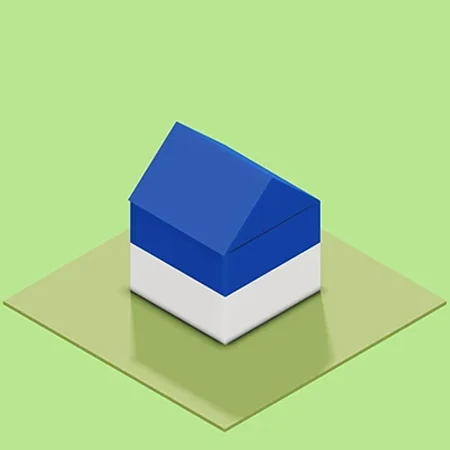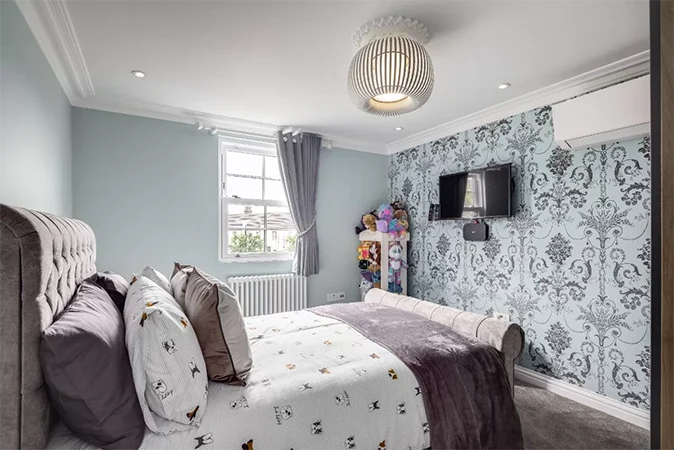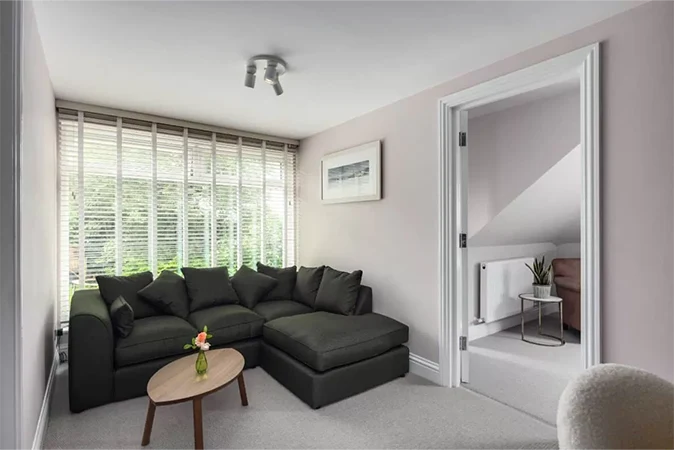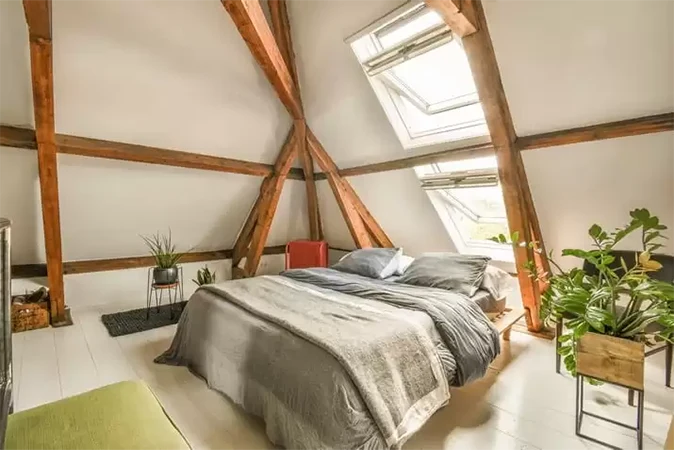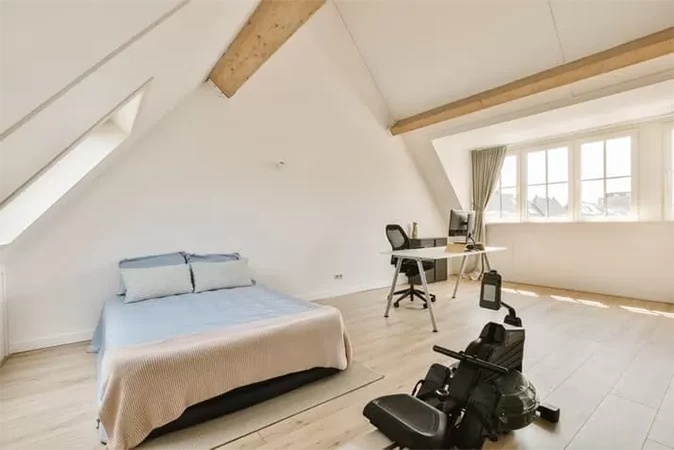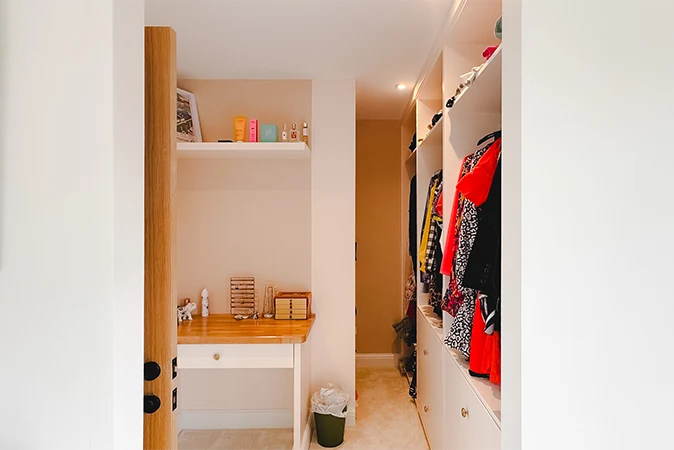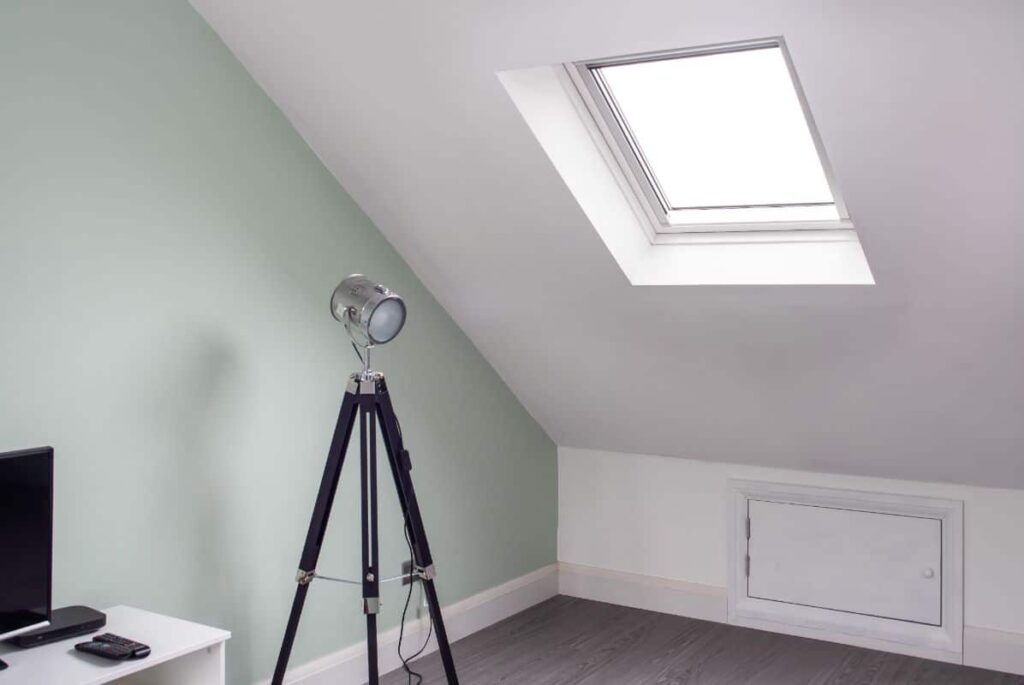Loft conversions are an excellent way to extend your home as they can free up space you might not otherwise have while also adding value to your property. However, the loft conversion we envision often conflicts with our property’s structural layout and awkward loft features present in the loft, making designing a space something of a challenge.
In our article, we share our top design tips for awkward spaces, providing you with inspiration and hopefully some solutions, so you can unlock the full potential of your loft conversion and turn obstacles into opportunities.
Utilise low-hanging eaves
There are likely areas of your loft that offer little headroom, so you might be wondering how best to use the space. Thankfully, there are many design options available to avoid making this part of your floor plan redundant.
Take advantage of space under the eaves for storage units such as ottomans, filing cabinets or ornaments. Bathtubs and toilets can also be placed in tactical, low-lying places to free up space in areas with more height. Whether it is an extra bedroom, bathroom, play area or office, utilising low eaves to take advantage of all available space can make a real difference to your home.
Make structural features a focal point
The structural features of your loft might be causing you some anxiety, but they do not need to be a hindrance. You can make the most of natural alcoves for custom-made furniture or turn them into reading nooks. When it comes to loft design, consider your walls – there are many floating shelving units, ideal for even the smallest space. The presence of beams will add character and can be used to suspend lights or to hang up décor. A chimney can also help create space for shelving, perfect for supporting paraphernalia, toys or stationery. It is much easier to work around your chimney than remove it.
Create levels
A mezzanine floor is a great way of changing the perception of space, giving you different levels to your loft conversion. What’s more, the space beneath the floor can be utilised to hold additional storage. You could place a bed on an upper floor with a seating area beneath or use the raised platform as an office space.
Creating a mezzanine level might also be a solution for ceilings with horizontal beams, as you can add volume to your loft conversion without removing them. You can further save space by opting for built-in steps or spiral staircases.
Furniture placement
A loft conversion is what you make it, which is why you shouldn’t underestimate the importance of furniture placement. Instead of having lots of bulky, free-standing furniture, commission custom-made pieces such as wardrobes and storage units that work around the existing features of your loft.
Look out for dual-purpose furniture like stools, beds and coffee tables that double up as storage, saving you from having too much clutter on show. By being mindful of your layout, you can optimise your entire floor plan.
Custom-Made Solutions
Embracing the unique architectural features of your loft, such as sloping ceilings and alcoves, requires a tailored approach to furniture design. Instead of relying on off-the-shelf solutions, consider commissioning custom-made pieces that seamlessly integrate with the existing layout.
For instance, bespoke wardrobes and storage units can be crafted to fit snugly into alcoves or under eaves, maximising storage capacity without encroaching on precious floor space. These tailored solutions not only enhance functionality but also add a touch of sophistication and luxury to your loft interior.
Dual-Purpose Furniture
In a compact living space, every piece of furniture should serve a dual purpose to maximise efficiency and minimise clutter. Look for versatile furnishings that offer both style and functionality, such as ottomans with hidden storage compartments, beds with built-in drawers, or coffee tables that can be transformed into dining tables.
By embracing multi-functional furniture, you can make the most of limited square footage while maintaining a clean and organised aesthetic. These space-saving solutions not only declutter your living area but also add flexibility and adaptability to your loft layout.
Mindful Layout Design
The key to optimising your loft conversion lies in thoughtful layout design that balances form and function. Before arranging furniture, take into account the flow of natural light, traffic patterns, and focal points within the space. We recently completed a loft conversion in Richmond upon Thames for an interior designer, this lady done this perfectly and that is what give us the inspiration for this blog.
Consider creating distinct zones for different activities, such as a cozy reading nook by the window, a designated workspace tucked away in a corner, or a communal gathering area centred around a statement piece of furniture. By delineating these functional areas, you can create a sense of cohesion and purpose throughout your loft while maximising its versatility and usability.
Harmonising Style and Space
While furniture placement is primarily about practicality, it also plays a crucial role in defining the overall aesthetic of your loft conversion. Choose furnishings that complement the architectural style and design theme of your space, whether it’s sleek and contemporary or rustic and industrial.
Opt for a cohesive colour palette and cohesive materials to create a sense of visual harmony and continuity. Consider incorporating statement pieces, such as a designer sofa or a vintage accent chair, to inject personality and character into your loft while adding visual interest and focal points.
Making the most of difficult loft spaces: Final thoughts
We hope this article from the loft experts at LMB Lofts in Surrey has provided you with inspiration for your challenging loft space and given you some insight into how to work around difficult structural features.
With some planning, there are plenty of ways to turn the quirky structural elements of your loft to your advantage. Remember, the loft conversion experts here at LMB Lofts have worked on countless lofts of all shapes and sizes over the years and can use their considerable technical and creative talents to help you design your dream loft space. Why not get in touch with our experienced team to find out more?






